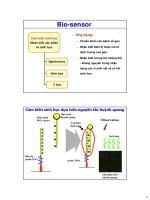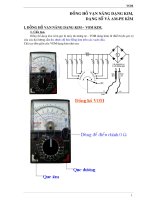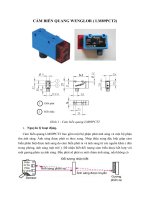- Trang chủ >>
- Khoa Học Tự Nhiên >>
- Vật lý
Cảm biến quang học
Bạn đang xem bản rút gọn của tài liệu. Xem và tải ngay bản đầy đủ của tài liệu tại đây (203.21 KB, 9 trang )
Introduction
Optical sensors are measuring devices in which a measured quantity is converted
to an optical and, subsequently, an electrical signal by means of an optoelectronic
transducer ([10]). Optical sensors belong to the class of contactless methods of
measurement eliminating backward influence of a measuring device on an object of
measurement.
As output signals from optical sensors are of an electronic nature and the
methods of their further conditioning are generally known, the main attention will be
devoted to the optical part of a sensor.
Giới thiệu
Cảm biến quang học có phương tiện đo trong đó một số lượng đo được chuyển đổi
đến một quang học và sau đó, một tín hiệu điện bằng phương tiện của một
Optoelectronic transducer ([10]). Cảm biến quang thuộc về lớp học của các phương
pháp tiếp xúc của đo lường loại bỏ lạc hậu, ảnh hưởng của một thiết bị đo trên một đối
tượng của đo lường.
Khi tín hiệu đầu ra từ bộ cảm biến quang học là một tính chất điện tử và các
phương pháp điều thêm của họ thường được biết đến, được sự quan tâm chính sẽ được
dành cho một phần của bộ cảm biến quang học một.
2.1. Optical waveguides and fibers
The simplest structure of an optical fiber used in optical sensors consists of a
circular core with a cylindrical coating layer ([33]).
The index of refraction of a core, nj, is always larger than that of coating, np. The
zero loss propagation of light along the fiber requires the fulfillment of conditions
for the total internal reflection, which are reached
2.1. Waveguides và sợi quang
Cơ cấu đơn giản nhất của một sợi quang được sử dụng trong bộ cảm biến quang học
bao gồm một
Thông tư nhân với một lớp sơn hình trụ ([33]).
Chỉ số của khúc xạ của lõi một, nj, luôn luôn lớn hơn của lớp phủ, np. Cái
không mất tuyên truyền của ánh sáng dọc theo sợi đòi hỏi việc hoàn thành các điều
kiện để phản ánh tổng số nội bộ, được đạt đếna
For internal reflection on the boundary between the core and the coating (Figure
2.1) the value of the critical angle may be found from the formula
Để phản ánh nội bộ trên ranh giới giữa lõi và các lớp phủ (Hình
2.1), giá trị của góc quan trọng có thể được tìm thấy từ công thức
The light introduced into the fiber with a certain angle will continue to reflect off
the walls of the fiber and thus can travel long distances in the fiber.
Ánh sáng đưa vào sợi với một góc độ nào đó sẽ tiếp tục phản ánh giảm giá
các bức tường của sợi và do đó có thể di chuyển xa trong sợi.
2.2. Light sources and detectors
2.2.1. Light sources
From the variety of existing light sources (incandescent lamps, halogen lamps,
etc.) only semiconductor sources ([8],[9],[19]) will be briefly described.
2.2.1.1. Semiconductor sources of light
Solid-state light sources such as light emitting diodes (LEDs) can produce light
by means of electroluminescence. Under specific conditions coherent light can be
produced in laser diodes.
Other technologies such as the Texas Instruments’ micromirror devices, called
“digital light processors”, belong to the category of electronically-controlled light
2.2. Nguồn ánh sáng và thiết bị dò
2.2.1. Nguồn ánh sáng
Từ nhiều hiện có nguồn ánh sáng (đèn sợi đốt, đèn halogen,
vv) nguồn bán dẫn chỉ ([8], [9], [19]) sẽ được miêu tả ngắn gọn.
2.2.1.1. Bán dẫn nguồn của ánh sáng
Solid-state nguồn ánh sáng như điốt phát ra ánh sáng (LED) có thể sản xuất ra ánh sáng
bằng phương tiện của electroluminescence. Dưới điều kiện cụ thể mạch lạc ánh sáng có
thể được
sản xuất tại điốt laser.
Các công nghệ khác như thiết bị micromirror của Texas Instruments ', gọi là
"Bộ vi xử lý kỹ thuật số ánh sáng", thuộc về chủng loại đèn điện tử điều khiển
sources important in measuring tasks working with structured light (machine vision,
videometry).
nguồn quan trọng trong đo lường công việc làm việc với ánh sáng có cấu trúc (máy tầm
nhìn,
videometry).
Light Emitting Diode structure
LEDs are p-n junction devices constructed of junctions producing IR or visible
light (e.g. gallium arsenide – GaAs, but not Si or Ge). The junction in an LED is
forward biased and when electrons cross the junction from the n- to the p-type
material, the electron–hole recombination process produces some photons in the IR
or visible range in a process called electroluminescence.
An LED is a directional light source, with the maximum emitted power in the
direction perpendicular to the emitting surface (most of the energy is emitted within
20º of the direction of maximum light). Most of the LEDs include plastic lenses to
spread the light for a greater angle of visibility.
Light emitting diode cấu trúc
LED là thiết bị xây dựng đường giao nhau của các mối nối pn IR sản xuất hoặc có thể
nhìn thấy
ánh sáng (ví dụ như gali arsenide - GaAs, nhưng không phải Si hoặc Ge). Các đường
giao nhau trong một LED là
chuyển tiếp điện tử thành kiến và khi băng qua đường giao nhau từ n-to-p các loại
vật liệu, các electron-hole tái kết hợp quy trình sản xuất một số photon trong IR
hoặc có thể nhìn thấy nhiều trong quá trình gọi là electroluminescence.
LED An là một nguồn ánh sáng định hướng, với sức mạnh được phát ra tối đa trong
hướng vuông góc với bề mặt phát xạ (phần lớn năng lượng được phát ra trong vòng
20 º của sự chỉ đạo của ánh sáng tối đa). Hầu hết các đèn LED bao gồm các ống kính
bằng nhựa để lan truyền ánh sáng cho một góc lớn hơn của tầm nhìn.
One way to construct an LED is to deposit three semiconductor layers on a
substrate (Figure 2.3). Between p-type and n-type semiconductor layers, an active
region emits light when an electron and hole recombine. If the p-n combination is a
diode and when the diode is forward biased, holes from the p-type material and
electrons from the n-type material are both driven into the active region. In this
particular design, the layers of the LED emit light all the way around the layered
structure. The LED structure is placed in a tiny reflective cup so that the light from
the active layer will be reflected toward the desired exit direction.
Một cách để xây dựng một đèn LED là tiền đặt cọc ba lớp bán dẫn trên một
chất nền (Hình 2,3). Giữa p-type và n-lớp bán dẫn loại, một hoạt động
khu vực phát ra ánh sáng khi một điện tử và recombine lỗ. Nếu p-n là một sự kết hợp
Diode và khi diode được chuyển thành kiến, lỗ từ p-vật liệu và kiểu
electron từ n-loại nguyên liệu đều được cả hai hướng vào các khu vực hoạt động. Trong
đặc biệt là thiết kế, các lớp của đèn LED phát ra ánh sáng tất cả các con đường quanh
lớp
cơ cấu. Cơ cấu LED được đặt trong một chén nhỏ để phản chiếu ánh sáng từ
lớp hoạt động sẽ được phản ánh về phía hướng thoát ra mong muốn.
2.2.1.2. Laser diodes
Laser action (with the resultant monochromatic and coherent light output) can be
achieved in a p-n junction formed by two doped GaSe layers. The two ends of the
structure need to be optically flat and parallel, with one end mirrored and the other
partially reflective. The length of the junction must be precisely related to the
wavelength of the light to be emitted.
The junction is forward biased and the recombination process produces light as
in the LED (incoherent). Above a certain current level the majority of the charge
carriers are in high energy states (population inversion). Population inversion
(Figure 2.5) leads to stimulated emission, the photons moving parallel to the
junction initiate a laser action.
The photons produced by stimulated emission form a standing wave
(constructive interference) in the resonator. The distance between the parallel highly
reflective mirrors of the optical resonator is matched to the wavelength of the laser
radiation and only a very small part of it is coupled out of the resonator.
2.2.1.2. Laser diode
Laser hành động (với các kết quả đầu ra ánh sáng đơn sắc và mạch lạc) có thể được
đạt được trong một đường giao nhau pn tạo thành bởi hai lớp doped GaSe. Hai kết thúc
của
cơ cấu cần phải được quang học phẳng và song song, với một đầu được nhân đôi và
khác
một phần phản xạ. Chiều dài của đường giao nhau phải được chính xác liên quan đến
bước sóng của ánh sáng sẽ được phát ra.
Đường giao nhau này được chuyển thành kiến và quá trình tái kết hợp tạo ra ánh sáng
như
trong (LED không liên tu
̣
c). Trên một mức độ nhất định hiện hành của đa số phụ trách
các
tàu sân bay nằm trong tiểu bang năng lượng cao (dân số đảo ngược). Dân số đảo ngược
(Hình 2,5) dẫn đến phát thải kích thích, các photon chuyển động song song với
đường giao nhau bắt đầu một hành động laser.
Các photon sản xuất bằng hình thức phát xạ kích thích một làn sóng đứng
(xây dựng can thiệp) trong các tiếng kêu vang. Khoảng cách giữa song song các cao
gương phản chiếu của tiếng kêu vang quang là phù hợp với bước sóng laser
bức xạ và chỉ có một phần rất nhỏ của nó là kết trên các tiếng kêu vang.
2.2.2. Light detectors
2.2.2.1. Photoresistors
Photoresistors are devices whose resistance changes upon light entering the
surface. The most common materials for their fabrication are cadmium-based
materials (CdSe, CdS, CdTe), working in the visible range of the spectrum (400 nm
to 700 nm). In the infrared range (1.4 m to 3 m) lead-based materials prevail
(PbS, PbSe, PbTe). For the range from 3 m up to 1 mm indium-based materials
(InSb, InAs) and doped Si and Ge are suitable.
Analysis shows that a single photon releases about 900 electrons for conduction
making a photoresistor work as a photomultiplier and therefore is a very sensitive
device.
The time response of a photoresistors is usually slow (fractions of a second) and
they find applications in light switches (street lamps switching), automatic headlight
dimmers in cars, flame detection, measurement of density of toner in photocopying
machines, etc.).
2.2.2. Ánh sáng dò
2.2.2.1. Photoresistors
Photoresistors là thiết bị có sức đề kháng thay đổi theo ánh sáng vào
bề mặt. Các tài liệu phổ biến nhất của họ được chế tạo dựa trên cadmium
vật liệu (CdSe, CdS, CdTe), làm việc trong phạm vi có thể nhìn thấy của quang phổ
(400 nm
đến 700 nm). Trong phạm vi hồng ngoại (1,4 μm đến 3 μm) dẫn dựa trên các tài liệu ưu
tiên áp dụng
(PBS, PbSe, PbTe). Đối với phạm vi từ 3 μm đến 1 mm indi dựa trên nguyên vật liệu
(InSb, InAs) và doped Si và Ge là phù hợp.
Phân tích cho thấy rằng một bản phát hành photon đơn khoảng 900 cho các điện tử dẫn
điện
làm một công việc photoresistor như là một quang tử và do đó là rất nhạy cảm
thiết bị.
Các thời gian đáp ứng của một photoresistors thường chậm (phân số của giây) và
họ tìm thấy ứng dụng trong công tắc đèn (đèn đường chuyển mạch), đèn pha tự động
Dimmers trong xe, ngọn lửa phát hiện, đo mật độ của mực in photocopy
máy móc, vv).
2.2.2.2. Photodiodes
If a p-n junction of a photodiode is forward biased and is exposed to light of a
proper wavelength, the current increase will be very small with respect to a dark
current. If a junction is reverse biased, the current will increase quite noticeably.
Impinging photons create electron–hole pairs. Correspondingly, the created holes
flow to the negative terminal meaning that a photocurrent flows in the network. The
voltage-to-current response of a typical photodiode is shown in Figure 2.6.
2.2.2.2. Photodiodes
Nếu một đường giao nhau pn của photodiode là một thành kiến và mong được tiếp xúc
với ánh sáng của một
bước sóng thích hợp, sự gia tăng hiện nay sẽ rất nhỏ đối với một tối
hiện tại. Nếu đường giao nhau một là đảo ngược thành kiến, việc hiện tại sẽ tăng khá rõ
rệt.
Photon Impinging tạo cặp electron-lỗ. Tương ứng, tạo ra các lỗ
dòng chảy đến ga phủ định nghĩa là một photocurrent chảy trong mạng. Cái
điện áp-to-phản ứng hiện nay của một photodiode điển hình được hiển thị trong hình
2.6.
There are two general operating modes for a photodiode: the photoconductive









